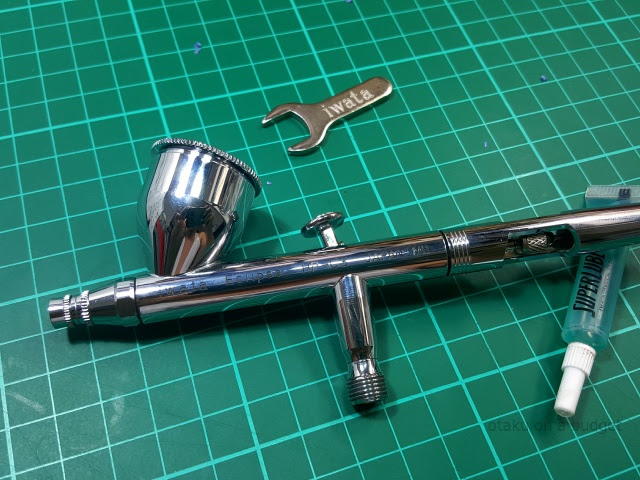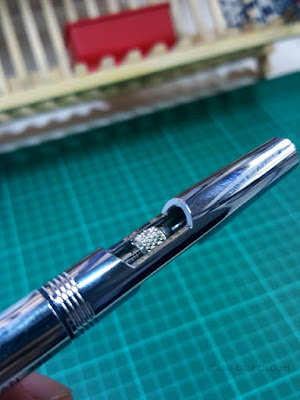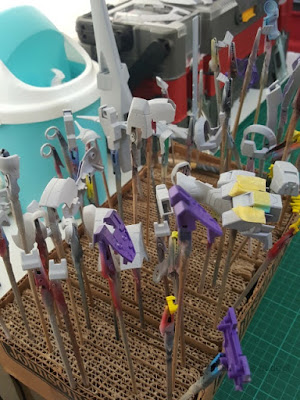Click on the Read More link for the rest of this post...
Features
The Iwata Eclipse HP-CS is a gravity feed airbrush from the popular Eclipse line, which is the middle ground between Iwata's entry level Revolution and acclaimed High Performance Plus product lines. It comes with a .35 mm head setup, 1/3 oz color cup, a metal cup lid, a cutaway for access to the needle lug, a fully protective nozzle cap, and takes a standard 1/8 air hose fitting.
The machining is near perfect, as is the chrome finish. The inside of the cup is exceptionally polished, and in this aspect it totally outclasses the Badgers. The trigger action is very smooth, has absolutely zero left/right wiggle, and pull-back action feels very firm. The spring tension is adjustable if it feels too stiff. The Eclipse is sold in different packages, but the one I got came with a head wrench and a tube of needle lube. Check out Don's review of the airbrush if you'd like to see the full breakdown of parts here: Don's Airbrush Tips - Iwata Eclipse HP-CS
Performance
Iwata claims the Eclipse is suited to airbrush-ready or thicker types of paint. After painting with Mr. Color lacquers, I found that it does indeed require less thinning than the Badger Krome's .33 setup to achieve good atomization, despite an almost similar head size. Comparing the Eclipse .35 and Krome .33 needles, the taper on the Eclipse needle is longer than the Krome needle.
The Eclipse needle is also thicker and longer than the Krome's. After getting used to the open tip design of the Badgers, I was glad that the nozzle cap on the Eclipse is a separate part, and can be removed if you want to paint with the needle fully exposed. Back-flushing can still be done without the protective needle cap, by slightly loosening the head assembly.
Testing some scribbles on paper shows that the Eclipse is also capable of tight lines despite the mid-sized setup. I can do tighter lines with the Krome's .33 (cheating with the needle limiter), but the Eclipse sprays broader when pulling all the way back on the trigger. Trigger response does not feel as sensitive as the Badger Krome's default trigger - it actually behaves more like the high-roller trigger, which means it's a bit easier to control out of the box.
 |
| Iwata .35(top) vs Krome .33 (bottom) |
The Eclipse needle is also thicker and longer than the Krome's. After getting used to the open tip design of the Badgers, I was glad that the nozzle cap on the Eclipse is a separate part, and can be removed if you want to paint with the needle fully exposed. Back-flushing can still be done without the protective needle cap, by slightly loosening the head assembly.
Testing some scribbles on paper shows that the Eclipse is also capable of tight lines despite the mid-sized setup. I can do tighter lines with the Krome's .33 (cheating with the needle limiter), but the Eclipse sprays broader when pulling all the way back on the trigger. Trigger response does not feel as sensitive as the Badger Krome's default trigger - it actually behaves more like the high-roller trigger, which means it's a bit easier to control out of the box.
The Eclipse feels solid and well balanced in the hand. It weighs a little less than the Krome, but it feels heftier because it has a shorter and thicker body. I'm painting the Kimaris Trooper with it and am having so much fun shading and highlighting - it's no wonder modelers hold the Eclipse in such high regard - it just atomizes paint really well, is very forgiving when it comes to paint thinning, gives good control, and is so easy to clean!
Cleaning
The main reason I even considered this airbrush - and what separates it from the rest of Iwata's offerings - is the large, self-centering, thread-less nozzle. The nozzle is kind of a hybrid, with what looks like a screw-in tip permanently attached to a large brass or copper body, very similar to the Patriot's nozzle. Combined with a super polished cup, this makes the Eclipse even easier to clean than the Patriot.
Here's a comparison of the Krome and Eclipse cups - you can clearly see the difference in polish. When I swish the paint around in the cup it slides down rather than clings to the walls - almost like the Eclipse's cup is treated to some sort of hydrophobic coating...
 |
| Eclipse (left) vs Krome (right) |
Between color changes I just flush it with cleaner, gargle, flush again, swab the needle tip and wipe the cup clean. After a session I take apart the head and soak the nozzle in cleaner while I wipe off paint from the needle and clean the inside of the brush. The gap between the cup and the needle packing seems deeper than the Badgers, so an occasional deep clean may be needed if there is paint buildup in that area.
Here's a short video showing the airbrush in action...
Summary
With the .35 nozzle and a less jumpy trigger, this airbrush is capable of pretty much anything you throw at it - shading, fine lines, full coating, and so on. There are also aftermarket options available: a crown cap for less turbulence when spraying close to your subject, a handle with a built in needle limiter for consistent line thickness and an alternate .5 setup for even broader coverage.
If you want to order the Iwata Eclipse, click on the Amazon ad link below. As an Amazon Associate I earn from qualifying purchases. Thanks!
That's it for now, but drop by again soon as I have another airbrush review coming up which you won't want to miss! Until next time, keep building plamo!
























No comments:
Post a Comment